I’ve often heard the statement “Oh! but you’re a blogger you must find magazine old-fashioned!” No, actually i don’t. I love mags, i love paper and beautiful graphics. I like adding notes in the margins and having something to read while i wait for the metro.
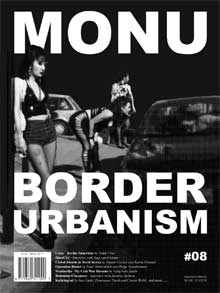 The 8th edition of MONU is dedicated to Border Urbanism.
The 8th edition of MONU is dedicated to Border Urbanism.
The mag opens with an interview with a dead-pan Joep van Lieshout describing life inside Slave City and his interest for the non-buildable architecture and urbanism (see Slave City and SlaveCity – The Board Room).
Expected borders are analyzed in an innovative way, for example there’s a very engaging comparison of Tijuana vs. San Diego’s architecture and urban strategies. Then there are the more unusual destinations: the “island” situation of Kalingrad, the borders built inside city centers (with Istanbul, its gated communities and the “camps” where refugees and immigrants confine themselves), Ceuta and Gibraltar as a case study to explore “borderscape”, the border city of Teplice in Czech Republic dissected in an interview with its Mayor, etc.
The pages i found most striking show a map of The Unrepresented Nations and Peoples Organization (UNPO). The members of this democratic, international organization are indigenous peoples, occupied nations, minorities and independent states or territories which lack representation internationally. And there’s way more of them than i expected.
MONU is currently looking for essays, photography, art projects or design concepts for its #9 issue which will investigate what the term exotic actually means for our cities and how exotic urban elements appear, what they look like, and how they may influence our cities. Submissions should be sent to info at monu-magazine dot com by the end of June 2008.
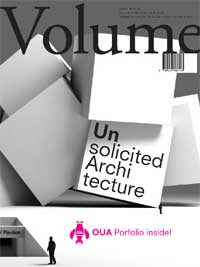 Volume‘s self-inflicted mission is to go beyond architecture’s definition of ‘making buildings’, to reach out for global views on designing environments, advocate broader attitudes to social structures, and reclaim the cultural and political significance of architecture.
Volume‘s self-inflicted mission is to go beyond architecture’s definition of ‘making buildings’, to reach out for global views on designing environments, advocate broader attitudes to social structures, and reclaim the cultural and political significance of architecture.
The issue encourages architects to have a more pro-active and sometimes slightly irreverent attitude towards the social needs, to take advantage of emerging opportunities and look for new territories for intervention.
The central part of the magazine exemplifies the idea by presenting the portfolio of the Office for Unsolicited Architecture, a practice –founded by Ole Bouman and students of MIT– which blends in a unique way fun with concern for pressing issues. There’s a list of past projects which inspired the transgressive attitude of OUA: Michael Rakowitz’ inflatable shelters for the homeless, Robert Venturi and Denise Scott Brown’s book Learning From Las Vegas for the way it embraces “low-brow” architecture, Santiago Cirugeda‘s work (of course), Jurgen Bey’s Garden Bench, Gordon Matta-Clark’s Odd Lots, etc.
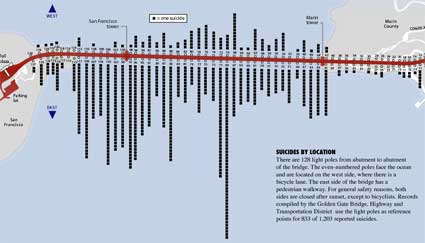 Suicides by location (SF Gate)
Suicides by location (SF Gate)
Then come 7 projects by OUA which each engage with a key playground for unsolicited architecture (border zones, (il)legality, global climate change, shelter, new technologies, etc.) Most are extremely witty and appealing. I especially liked The Golden Gate Remains which addresses the high number of people who chose this national landmark to commit suicide, the lack of cemeteries in San Francisco and the difficulty to raise fundings to maintain the bridge. OUA’s solution is The Golden Gate Columbarium which would both host the cremated remains of the suicides and constitute a barrier to prevent future desperate acts.
The last part showcases some rather interesting unsolicited interventions by architects and artists from around the globe.
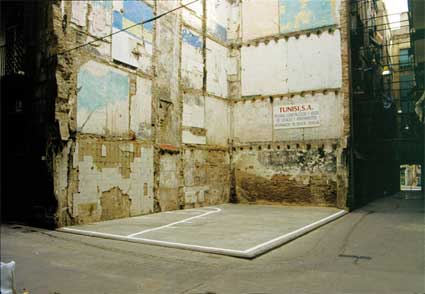 Basketball Court, by Harmen de Hoop
Basketball Court, by Harmen de Hoop
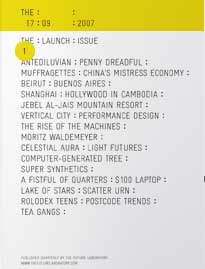 Now for the freebie! THE is a quarterly magazine, showcasing the best design and trend ideas from around the world. So yes, it’s cool hunting and i’m not particularly into that but i found some of the most in-depth articles in this magazine surprisingly smart and fun to read.
Now for the freebie! THE is a quarterly magazine, showcasing the best design and trend ideas from around the world. So yes, it’s cool hunting and i’m not particularly into that but i found some of the most in-depth articles in this magazine surprisingly smart and fun to read.
To be added to THE mailing list, fill in your details in LifeSignsNetwork.net and they’ll send you the mag for free.
The last magazine i recently got my hands on is the venerable Domus which had a dossier on surveillance. The dossier is actually quite ok. Not groundbreaking if you’ve been following the discourse about surveillance over the past two years and certainly not half as exciting as most art project commenting on the phenomenon but still worth a look. I must say though that the rest of the issue is quite appalling. Are people really turned on by the sight of shiny bathrooms and immaculate kitchen table tops?
